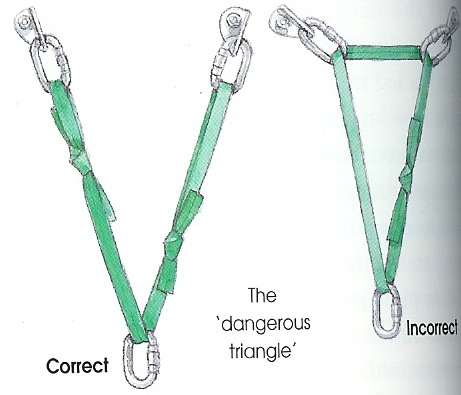The Anchor System and the Forces Behind It
Knowing how to make an anchor system is an essential skill a rock climber must have. An anchor allows you to make belay, rappel, and top rope anchor stations. An anchor system is supposed to be "bombproof", meaning that nothing should break or snap. A double decker bus should be able to hang from the anchor system without breaking anything.
An anchor system usually consists of at least three anchors which are attached to an immovable object such as a tree (if you are top roping), boulder, or a crack in a rock. An anchor should have at least three anchors to help distribute the weight and back up the other anchors in case one breaks.
A lot of forces act on an anchor system. A rock climber has to know how the forces will affect the anchor. If the anchors are set badly, it could fail. In setting up an anchor, a climber usually inserts a piece of gear into a crack, which will exert a force to prevent it from disengaging. This piece of gear can be either a nut, camming device (ACD), quickdraw (if you are sport climbing), piton, pegs, or a wedge. (Quickdraws are two carabiners connected with webbing or some sort of sling.) Wedges and pegs are tapped in with a hammer and nuts or chocks, are slid into cracks (Hattingh 80). Active Camming Devices (ACD's) uses springs to hold it in a crack.

(Hattingh 43)
The photo above shows a variety of anchors that can be used to clip the rope into. Anchors take some of the force of the fall and shorten the distance of a fall, which decreases the fall factor.
The photo below shows how a specific anchor, the ACD ( active camming device), works. What is cool about camming devices is how they work. When a force pulls down on a camming device that has been placed in a crack, it exerts a force twice the pulling force on to the rock surrounding the cam.

(Luebben 105)
As you can see from
the picture above, the downward force is halved on each side and the outward
force is twice the downward force. This outward force creates friction,
keeping the camming device in place and opposing the downward pull of the
climber (Mastering Basic Skills).

(Luebben 116)
One anchor system to avoid is the American Triangle. The American Triangle can be shown by force vectors to be unsafe and dangerous because it increases the forces on the system. You break the triangle by making a V-shaped anchor. The V-shaped anchor is much safer and places less force on the anchor system.

(Hattingh 82)
Links to other places in "The Physics
of Rock Climbing":